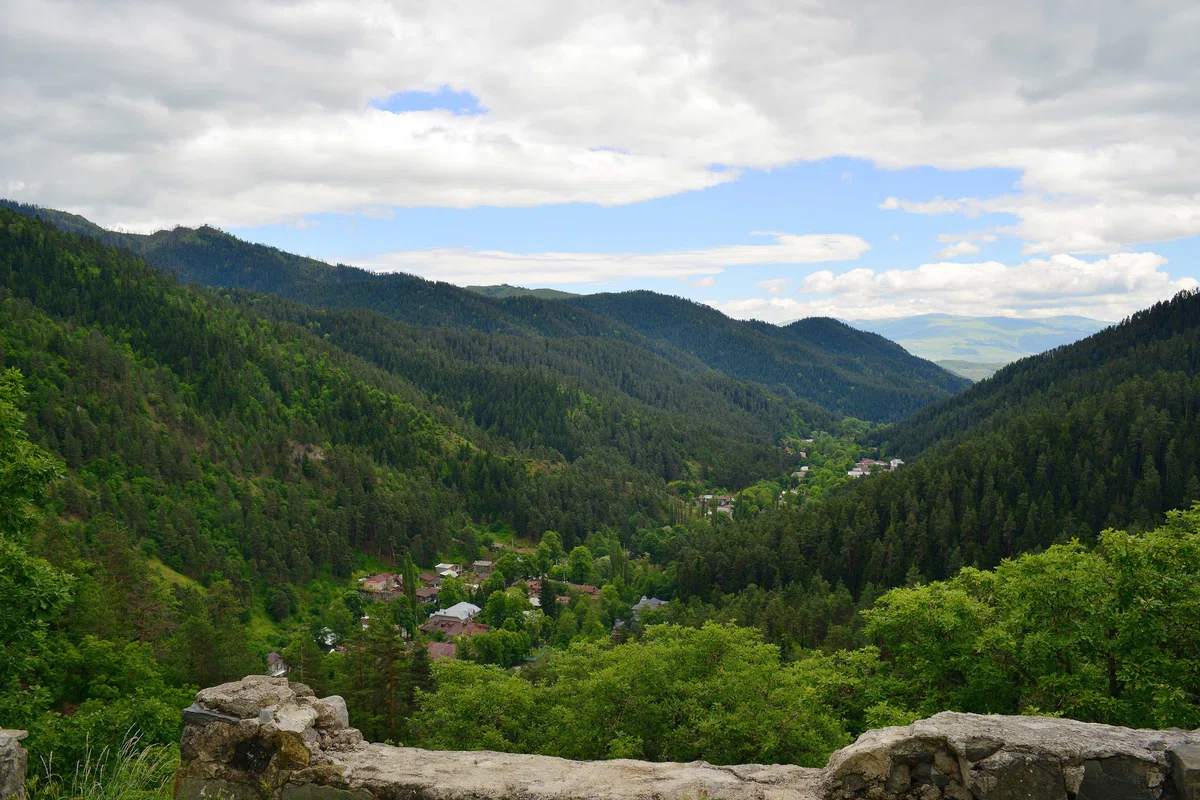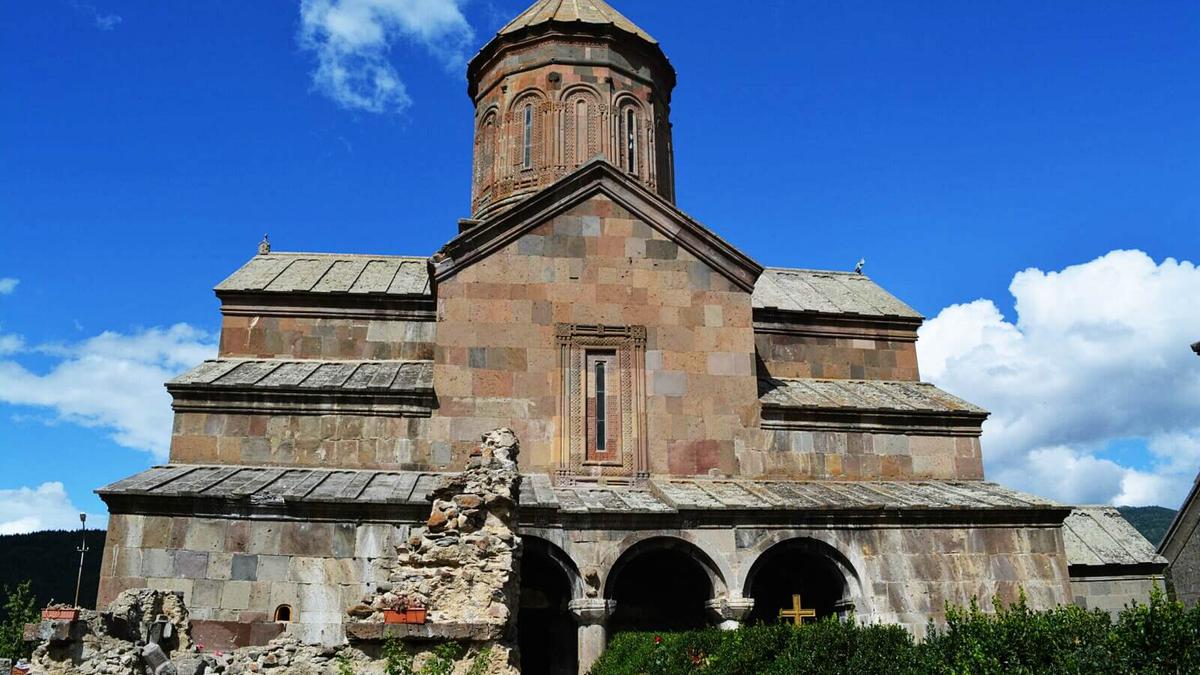
Resort places worth visiting in Georgia. Abastumani Resort.
Abastumani resorts is known for its climatic conditions, which are the main factor in the treatment of many diseases. There are also many weakly mineralized sources of thermal waters. The infrastructure of the resort began to be built a long time ago. The place is ideally developed for receiving tourists.
On the southern slopes of the Meskheti ridge, covered with coniferous trees, there is the famous mountain climatic and balneological resort of Abastumani, whose climate is curative for lung diseases. It is especially useful in spring, when pine pollination begins.
When breathing, yellow pollen enters the lungs and contributes to their recovery. Abastumani it is known not only for its climate - its main therapeutic factor - but also for hyperthermal, weakly mineralized springs ("Goliatistskaro" - 48.5 ° C, "velistskaro" - 42 ° C, "Suravandistskaro" - 39 ° C), the total flow rate of which is 1 million liters / day. These mineral waters are used in the treatment of many diseases.

ABASTUMANI RESORT
On the site of the modern resort at the beginning of our era there was a densely populated city of Odzrhe. Even in ancient times, this city was famous for its healing waters. As the outstanding Georgian geographer Vakhushti Batonishvili testifies, since the beginning of the XVII century, when the Turks dominated the city, they called this place "Chemik-Bogaz" ("chemik" - warm, "bogaz" - valley). The modern name probably comes from the surname of the local princes Abazasdze.
On the site of the modern resort at the beginning of our era there was a densely populated city of Odzrhe. Even in ancient times, this city was famous for its healing waters. As the outstanding Georgian geographer Vakhushti Batonishvili testifies, since the beginning of the XVII century, when the Turks dominated the city, they called this place "Chemik-Bogaz" ("chemik" - warm, "bogaz" - valley). The modern name probably comes from the surname of the local princes Abazasdze.
The scientific study of thermal healing waters began in the 70s of the XIX century. In parallel, they began to build the phthisiological resort of Abastumani. A great contribution to the development of the construction plan of the resort and its implementation was made by the head of the Department of Mineral Waters of the Tbilisi province, doctor Adolf Remmert. The foundation of the Tsagveri resort is also connected with his name. At the end of the XIX century, for the treatment of a serious lung ailment, the Grand Duke of Russia Georgy Alexandrovich Romanov settled in Abastumani. A bathhouse with therapeutic thermal waters and a palace were built especially for the tsarevich, in which the Meskheti sanatorium later functioned, and in 1994 a convent named after St. Nicholas was opened here. Panteleya.
On the initiative of the Tsarevich, in 1896-1899 a church named after St. Alexander Nevsky was built in Abastumani. This church is a kind of Georgian architectural monument of the VIII-IX centuries of Romanticism. Therefore, this church was called the "New Zarzma". In 1902-1904, the church was painted by the famous Russian artist Mikhail Nesterov.
Location: the southern slope of the Meskhemninsky (Adjara-Imereti) ridge, the valley of the Otskhi River
Distance: from Adigeni - 25 km, from Akhaltsikhe - 28 km. from Tbilisi 240 km
Altitude above sea level: 1250 1450 m
Relief: mountainous.
Climate: typical for the lower belt of the middle mountains, the winter is cold, snowy. The average temperature in January is 6 °C. Stable snow cover lasts from mid-December to the end of the second decade of March. The demo is moderately warm, the average temperature in August is 16'C
Wed. the amount of annual precipitation: 688 mm.
Average relative humidity per year: 77%.
Duration of sunshine per year: 1967 hours
Natural healing factors: the mild climate of the lower belt of the middle mountains. Thermal silicon, sulfate-chloride, calcium-sodium mineral waters, with a total mineralization of 0.6 g/dm3.
Types of treatment: mineral water baths, passive climate therapy.
Therapeutic indicators; all phases of the development of pulmonary tuberculosis, chronic and acute forms of pneumopleuritis, diseases of the osteoarticular and peripheral nervous systems, as well as gynecological diseases.

Abastumani is a unique resort located on the coniferous-covered southern slopes of the Meskheti Range in Georgia. It attracts tourists from all over the world with its exceptional climatic conditions, which are a major factor in the treatment of many diseases.
One of the key advantages of this resort is its salubrious climate, which is especially good for lung diseases. In spring, when the air is saturated with pine pollen, breathing here becomes especially beneficial for the respiratory system. The yellow pollen, getting into the lungs, helps to heal and strengthen them. However, it is famous not only for its climate. There are also hyperthermal, low-mineralized springs of thermal waters, which add additional value to the resort. Some of the famous springs include "Goliatistskaro" with a temperature of 48.5ºC, "velistskaro" with a temperature of 42ºC and "Suravandisskaro" with a temperature of 39ºC. The total flow rate of these springs reaches an astonishing one million liters per day. The mineral waters, rich in low mineralization, are widely used for the treatment of various diseases.
The resort's infrastructure is also noteworthy. For many years of development have been created excellent conditions for the stay and rest of tourists. Here you will find comfortable hotels, restaurants with Georgian cuisine, parks for walking and much more. All this makes it an ideal place for those who are looking not only for treatment, but also a pleasant and relaxing vacation. The resort is not only modern, but also has a rich historical past. At the beginning of our era, there was a town called Odzrhe, which was densely populated and known for its healing waters. Already in ancient times, this city attracted people with its healing properties of water springs. The town, as evidenced by the eminent Georgian geographer Vakhushti Batonishvili, was important even in the 17th century, when the city was ruled by the Turks. They gave it the name "Chemik-Bogaz" ("chemik" means "warm," and "bogaz" translates as "valley"). The name of the valley reflected the peculiarities of local natural conditions and springs with warm healing waters. The modern name of the resort probably derives from the surname of local princes Abazasdze, who at different periods of time had an influence on the development and prosperity of the region.
The scientific study of the area's thermal healing waters began in the late 19th century, in the 1870s. At that time, the construction of a phthisiatric spa in the region also began. Dr. Adolf Remmert, head of the mineral water department of Tbilisi province, played an important role in developing the plan of construction and implementation of the resort. He actively worked on creating the infrastructure and organizing the therapeutic process. As a result of his efforts, in 1890 Tsaghveri resort was also founded. At the end of the 19th century, Grand Duke George Alexandrovich Romanov of Russia settled in Abastumani to treat his serious lung disease. In his honor was built a special bath with curative thermal waters, and later on his order was built a palace, which later functioned as Meskheti sanatorium. In 1994, on the territory of former sanatorium there was founded a nunnery, named after Saint Panteleimon. At the initiative of Tsesarevich George Alexandrovich, in Abastumani was built Church of St. Alexander Nevsky in 1896-1899. This church was similar to the Georgian architectural monument of VIII-IX centuries, known as Zarzma. Because of this it was called "New Zarzma". The great Russian painter Mikhail Nesterov painted the church in 1902-1904, giving it a majestic and unique art.
Abastumani is located on the southern slope of the Meskhemni range, in the picturesque valley of the river Otskhi. This resort is located in close proximity to other cities in Georgia: just 25 kilometers from Adigeni, 28 kilometers from Akhaltsikhe and 240 kilometers from Tbilisi. It is located at an altitude of 1,250 to 1,450 meters above sea level and is surrounded by mountainous terrain. The climate here is typical of the lower belt of the middle mountains. Winters are cold and snowy, with an average temperature of 6°C in January. Snow cover usually lasts from mid-December to the end of the second decade of March. Summers are moderately warm with an average temperature of 16°C in August. The annual precipitation reaches 688 mm and the average relative humidity is 77%. The resort is also characterized by long hours of sunshine during the year, which amounts to 1967 hours. One of the main therapeutic factors of the resort is the mild climate of the lower belt of the middle mountains. There are thermal siliceous, sulphate-chloride and calcium-sodium mineral waters with a total mineralization of 0.6 g/dm³. Treatment at the spa includes mineral water baths and passive climatotherapy. There is a wide range of therapeutic indications for visiting the resort. All phases of pulmonary tuberculosis, chronic and acute forms of pneumopleuritis, diseases of the bone and joint and peripheral nervous system, as well as gynecological diseases are successfully treated here.
If you have any questions about the spa, its history or treatment options, please feel free to ask in the comments below. We are happy to answer all your questions and discuss topics of interest to you. Your feedback and opinions are also welcome.












10 comments
Log in to leave a comment
При дыхании жёлтая пыльца попадает в легкие и способствует их оздоровлению. А также с гипертермальными, слабоминерализованными источниками «Голиатисцкаро» - 48,5ºС, «велисцкаро» - 42ºС, «Суравандисцкаро» - 39ºС.
Изучение термальных вод началось с 1970-ых годов. Параллельно начали строить фтизиатрический курорт Абастумани. Для лечения тяжёлого недуга лёгких, в Абастумани поселился великий князь Георгий Александрович Романов. Специально для цесаревича построили баню с лечебными термальными водами и дворец, в котором позже функционировал санаторий «Месхети», а в 1994 года здесь открылся женский монастырь Св. Пантелея.
По инициативе цесаревичагодах была построена церковь Св. Алекандра Невского.